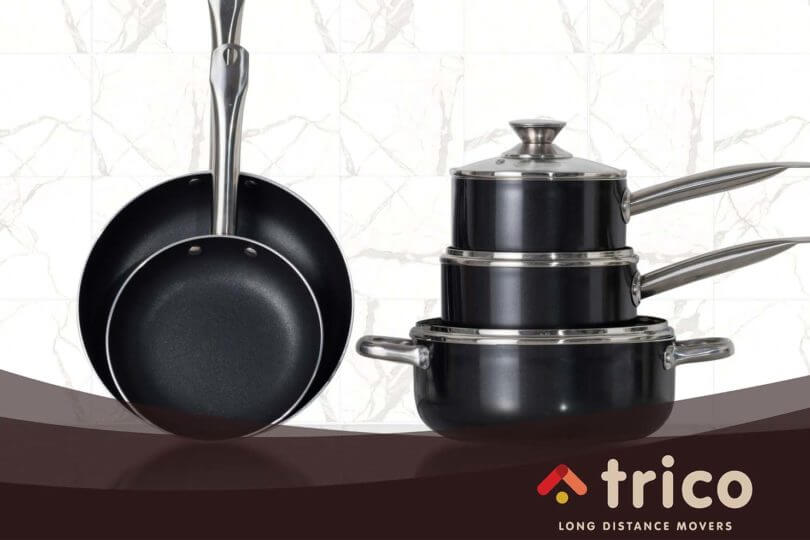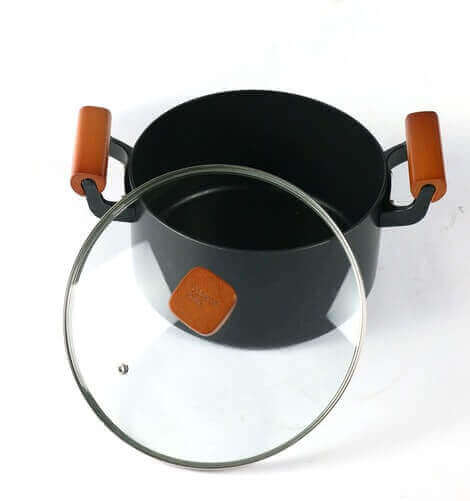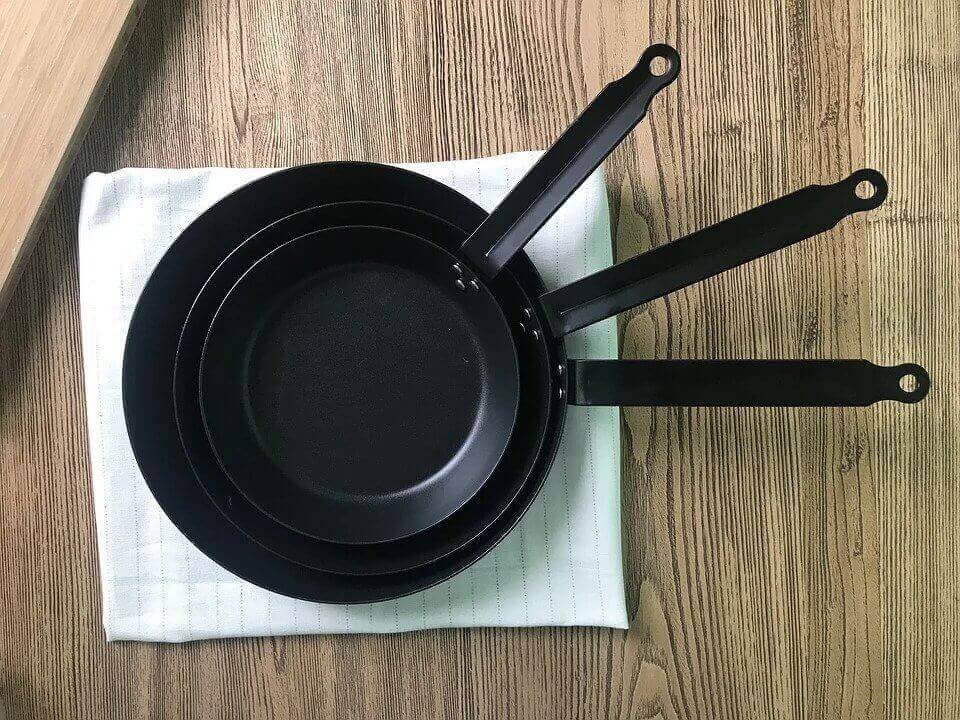When moving long distance, proper packing is key to an organized move, especially when it comes to the kitchen. How to pack pots and pans is one of the crucial questions you should be asking yourself if planning to relocate cross country soon. Without the right answer, all your expensive cookware and metal cooking gadgets can easily be broken during transportation.


Have you ever wondered how do you transport pots and pans? Most people don’t even think about this issue until they decide to move. Only then, they realize how awkwardly shaped are these cooking utensils. Even more, they are hard to stow and take up a lot of space. Unless you decide to leave your kitchen sets behind, you need to know how to pack quickly for a move. Safety and efficiency should be your priorities. And don’t worry if you’ve never done this before because, with our expert tips, we’ve got you covered.
Before you start wrapping things up, you should plan for what to pack and where to store your dishes. This way, you’ll have less cooking sets to store, and your relocation costs will be cheaper.
Look at this long distance relocation as your perfect chance to get rid of old and unnecessary kitchenware. And the truth is every household has some old cookware and containers that should be disposed of. If you take care of housekeeping and often cook meals, you know how many cooking containers you’ve accumulated over the years. The cooking vessel is among the first things you’ll need after the relocation to a new home, so why not make the selection of those you use the most, the old ones, and those you don’t want to bring with you or hardly ever use.
Keep in mind that cookware is heavy and difficult to stow. You’ll need a lot of boxes and sheets of paper to store all your kitchen sets properly. Why waste your precious time and energy stowing old or ugly items and pay higher moving costs? Suppose you’ve already hired professional long-distance movers, scheduled your relocation date, and arranged all the details. In that case, you’re familiar with the fact that removal expenses are based on your shipment’s volume or weight, or the number of possessions.
The next step is to decide which cookware is worth moving to your new home. Of course, get rid of scratched, dented, or wrapped cooking sets, or those you don’t like. Leave only the most practical and high-quality cookware. Make sure the dishes are perfectly clean in order to prevent damage to other household items or mold growth on your cooking utensils.
Why is it important to keep your dishes clean and dry? If you leave any trace of grease, it may saturate the wrapping material and box. This may further lead to weakening the strength of the cardboard and ruining other items. An additional problem may be moisture, which can also damage packages and wrapping materials. It might be especially disastrous for your cooking containers if mold growth appears. This step is especially important if you opt for storage service. So, make sure to pack and store clean and dry cookware only to prevent unpleasant and even irreparable damages.
Last but not least are packaging products which should be suitable for sturdy pieces of dishes as well as fragile elements. The most important packaging materials for your cookware are:

It’s not the same storing process if you move under 50 miles or more than 400 miles. If your relocation means transportation of your belongings to the other part of your current city, then a faster and easier way of stowing your cookware is to use garbage bags. Still, keep in mind that relocation across town with professional movers is not allowed without containers and proper wrappers.
Garbage bags are an excellent packaging material when moving locally, although kitchenware has sharp corners and awkward shape. If your move is not long-distance, heavy-duty garbage bags might be the best decision for faster stowing and unpacking. Take into consideration the rear ends of handless and clothe them in towels or bubble wrap. If possible, stack your dishes in one another and place them in the bags with longer handles facing towards the opening. When using opaque trash bags, make moving labels, and write down the content of the bag.
When relocating to another state or overseas, all your belongings need to be properly packed to prevent possible damage due to transportation and to keep your cooking sets from scratching each other. The same goes for the cookware with handles and lids. They should be protected with plenty of cushioning layers and placed into solid and sturdy containers. Keep in mind that kitchen utensils shouldn’t come into contact directly due to their weight and possible damage.
So, if you’ve prepared all the necessary packaging materials, let’s take a look at how to sheathe, stow, and bundle your cooking vessels into pads.

To perform the packing process rightly and avoid potential disruptions, several crucial steps should be followed:
Have you ever wondered what will happen when your cooking utensils are stacked inside each other? Firstly, they will take less space. Second, there will be fewer packages to carry, load, and pay for. This means, if you’re relocating by yourself, that the smaller vehicle will be enough for your packages and crates, and your costs of rental trucks for moving will be lower. And if you choose the services of professional movers, you’ll need to put aside less money due to the weight of your shipment.
That being said, this packing method is efficient and reliable. The largest cookware should be first, stacked with smaller ones. These should be carefully nestled in larger pieces with wrapping paper or towel between them. If some of the utensils are made of glass, it’s recommended not to stack anything on top. Don’t be tempted even if there’s room in the package, because glass is fragile and usually cracks under heavier items.
As we mentioned before, lids should be packed with the dishes they belong to. This will make your unpacking after a move easier, and you won’t risk losing any of them. However, glass lids require special attention because they can be easily broken. If you have bubble wrap, it will be perfect protection. You can also use a dishtowel or thicker towel, and then again wrap them with paper.
A frying pan is challenging for stowing because it’s made of non-stick materials or stainless steel, so to preserve its functionality, it mustn’t be scratched. Besides, with a long and thin handle, its wrapping and stowing process can make you crazy. But, don’t worry. With pan protectors, you can breathe a sigh of relief. Use a paper towel or dish towel as a barrier between your frying pan and other cookware. Good options are also products specifically designed for this purpose – felt or rubber pan protectors. They prevent contact between pans.
When relocating long distance, it’s good to know how to properly pack pots and pans using some additional tips and handy hacks. These are usually the ace in the sleeve, which can help you in situations such as lack of packaging products or having no idea how to stow larger pieces of dishes. So, here come bonus tips for wrapping up your cookware:
After these trips and tricks, we are sure you’ll become a real expert in stowing your cookware for a move. Of course, if you’re not sure in your packing skills, or simply don’t have the necessary supplies or time to perform this demanding job, you should contact professional packers and leave this process to them. They will handle your dishes with care thanks to efficient and secure packing services.